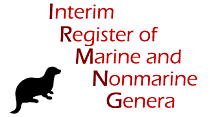
| Intro | | Search taxa | | Taxon tree | | Search literature | | Taxon match | | Homonyms | | Statistics | | Webservice | | Manual | | FAQ | | LifeWatch | | Download | | Log in |
IRMNG taxon detailsCoptocampylodon Elliott, 1963 †
Rhabdocoprolithus Bischoff, 1990 † · unaccepted
marine,
fossil only
Not documented
Taxonomic remark Ichnogenus (fossil coprolite). From Knaust, 2020: Previously regarded as acicularian spicules, Elliott (1963) tentatively...
Taxonomic remark Ichnogenus (fossil coprolite). From Knaust, 2020: Previously regarded as acicularian spicules, Elliott (1963) tentatively interprets C. lineolatus as the skeletal remains of a small octocoral. Very similar forms were described in open nomenclature by Gramann (1966) and assigned to coprolites, a view shared by Cuvillier et al. (1969). Other species erected under Coptocampylodon turned out to belong to dasycladacean algae instead of being coprolites, as reflected in the revised diagnosis by Ljubovic-Obradovic & Radoicic (2003), but are excluded from Coptocampylodon and accommodated in Carpathoporella or elsewhere (Schlagintweit et al. 2002; Schlagintweit & Gawlick 2009). Potential producer(s). Gramann (1966) and Gaillard (1978) suggested deposit-feeding molluscs (e.g. Nuculidae) as the producer, and Bischoff (1990) assumed Archaeogastropoda, possibly ancestral to the Trochacea, an interpretation consistent with modern analogues (Bandel 1974). Analysis of shape and chemical composition of C. lineolatus led Zivkovic & Bogner (2006) to confirm that the coprolites originated from deposit-feeding invertebrates. [details]
IRMNG (2021). Coptocampylodon Elliott, 1963 †. Accessed at: https://irmng.org/aphia.php?p=taxdetails&id=1052565 on 2025-09-12
Date action by
basis of record
Sepkoski, J. J., Jr. (2002). A compendium of fossil marine animal genera. <em>Bulletins of American Paleontology.</em> 363: 1-560., available online at https://www.biodiversitylibrary.org/page/10698313
note: as Gorgonacea [details] additional source Knaust, D. (2020). Invertebrate coprolites and cololites revised. <em>Papers in Palaeontology.</em> 2020: 1-39., available online at https://doi.org/10.1002/spp2.1297 [details] verified source for family Knaust, D. (2020). Invertebrate coprolites and cololites revised. <em>Papers in Palaeontology.</em> 2020: 1-39., available online at https://doi.org/10.1002/spp2.1297 [details] name verified source Knaust, D. (2020). Invertebrate coprolites and cololites revised. <em>Papers in Palaeontology.</em> 2020: 1-39., available online at https://doi.org/10.1002/spp2.1297 [details] current name source Knaust, D. (2020). Invertebrate coprolites and cololites revised. <em>Papers in Palaeontology.</em> 2020: 1-39., available online at https://doi.org/10.1002/spp2.1297 [details] extant flag source Sepkoski, J. J., Jr. (2002). A compendium of fossil marine animal genera. <em>Bulletins of American Paleontology.</em> 363: 1-560., available online at https://www.biodiversitylibrary.org/page/10698313 [details] habitat flag source Sepkoski, J. J., Jr. (2002). A compendium of fossil marine animal genera. <em>Bulletins of American Paleontology.</em> 363: 1-560., available online at https://www.biodiversitylibrary.org/page/10698313 [details] original description (of Rhabdocoprolithus Bischoff, 1990 †) Senckenb Lethaea 70 (1-3) page(s): 221 [details] Unreviewed
Descriptive info From Knaust, 2020: Stratigraphic distribution. Early-middle Silurian (Bischoff 1990), Upper Jurassic (Gramann 1966; Gaillard 1978) to Lower Cretaceous (Elliott 1963). [details]Taxonomic remark Ichnogenus (fossil coprolite). From Knaust, 2020: Previously regarded as acicularian spicules, Elliott (1963) tentatively interprets C. lineolatus as the skeletal remains of a small octocoral. Very similar forms were described in open nomenclature by Gramann (1966) and assigned to coprolites, a view shared by Cuvillier et al. (1969). Other species erected under Coptocampylodon turned out to belong to dasycladacean algae instead of being coprolites, as reflected in the revised diagnosis by Ljubovic-Obradovic & Radoicic (2003), but are excluded from Coptocampylodon and accommodated in Carpathoporella or elsewhere (Schlagintweit et al. 2002; Schlagintweit & Gawlick 2009). Potential producer(s). Gramann (1966) and Gaillard (1978) suggested deposit-feeding molluscs (e.g. Nuculidae) as the producer, and Bischoff (1990) assumed Archaeogastropoda, possibly ancestral to the Trochacea, an interpretation consistent with modern analogues (Bandel 1974). Analysis of shape and chemical composition of C. lineolatus led Zivkovic & Bogner (2006) to confirm that the coprolites originated from deposit-feeding invertebrates. [details]
To BioNames database (from synonym Rhabdocoprolithus Bischoff, 1990 †)
To ION (Index to Organism Names) (from synonym Rhabdocoprolithus Bischoff, 1990 †) |